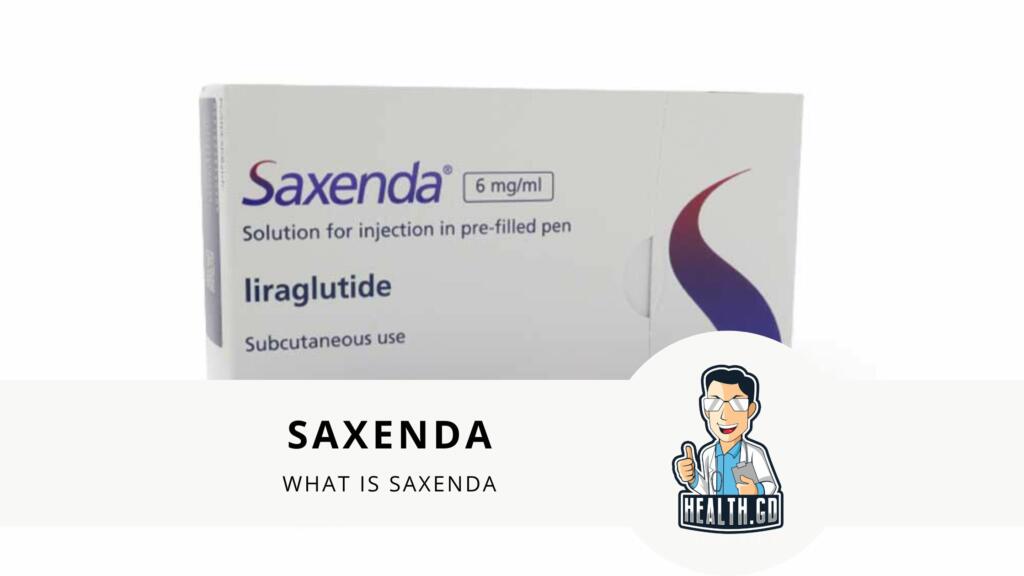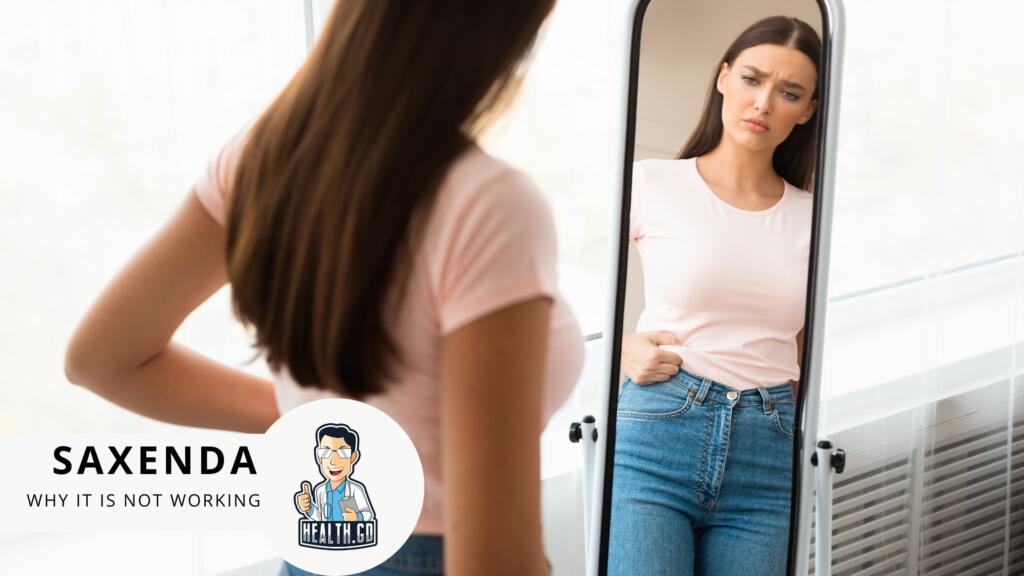
Are you taking Saxenda to lose weight but not seeing the results you expected? It can be frustrating and disheartening but don’t worry. There are various reasons why you not losing weight on Saxenda, and we’re here to help you figure them out. In this article, we’ll discuss the possible causes and solutions to help you get back on track with your weight loss journey.
What is Saxenda?

Saxenda is a medication that doctors prescribe to adults who have weight-related medical problems or obesity. It is also pescribed to children aged 12-17 years with a body weight above 132 pounds (60 kg) to help them lose weight and maintain weight.
How does Saxenda work?
Saxenda is given to the body through injections which contains liraglutide. Liraglutide belongs to a group of medications called GLP-1 receptor agonists, which help to regulate blood sugar levels and decrease appetite. As a result, you tend to eat less and lose weight over time.
How long does Saxenda take to work?

Saxenda can different time to work for different individuals.
It may take about eight weeks in adults to see a significant weight loss (at least 5%) with Saxenda. In the first 2 to 4 weeks, you may lose about 2% to 4% of your weight.
However, individual results may vary, and several factors can influence your weight loss progress while using Saxenda.
Generally, after taking the total 3mg dose of Saxenda for 12 weeks, most people have lost at least 5% of their starting body weight.
How much weight can I lose using Saxenda?

Saxenda was tested in a clinical trial involving 3,731 adult patients with a BMI of 27-29.9 who had at least one weight-related condition or a BMI of 30 without type 2 diabetes. During the 56-week study, 2,487 patients were given Saxenda and 1,244 were given a placebo, and all patients received counseling on a reduced-calorie diet and physical activity. The study results showed that 85% of patients taking Saxenda lost some weight.
In this study:
- 3 out of 5 people (62%) who took Saxenda achieved a significant weight loss of 5% or more.
- 1 out of 3 people (34%) who took Saxenda achieved an effective weight loss of 10% or more.
- 6% of the total number of people taking Saxenda achieved a weight loss of 20% or more.
The study results suggest how much effectivie Saxenda is for you.But individual results may vary from person to person.
Prolonged Use of Saxenda
A clinical study was formed to find about prolonged uses of Saxenda.
The study involved 2,254 adults with a BMI of 27 or greater and at least one weight-related condition, or a BMI of 30 or greater and pre-diabetes. During the study, 1,505 participants were given Saxenda, 749 were given a placebo, and all were provided the reduced-calorie meal plan and increased physical activity counseling. The study evaluated the number of people who lost 5% or more of their body weight.
At the end of the first year, 56% of the people who took Saxenda lost 5% or more of their body weight, compared to 25% of those who took the placebo. After three years, 747 people who took Saxenda and 322 who took the placebo continued the study and had their weight measured. Of those, 26% of the Saxenda group (391 people) lost 5% or more of their weight at both the 1- and 3-year marks, compared to 10% of the placebo group (74 people).
This clinical study lasted for three years.
After the rest, Saxenda was found to be effective for weight loss when combined with a reduced-calorie meal plan and increased physical activity.
How do you know if Saxenda is working?
To track your progress, record your weight and take measurements around your waist and thighs regularly, such as every week at around the same time of day.
Adults should aim to lose at least 4% of their body weight by their 4-month follow-up appointment. You can monitor your weight and the size of your waist or other body parts to see if Saxenda works for you.
If you are not getting desired results, you should stop taking it. In this case, a different weight loss treatment may be more suitable for you, and you can consult with a doctor to explore other options.
How quickly should you lose weight with Saxenda?
Saxenda immediately suppresses appetite, but it takes a while for the medication to affect weight loss.
When starting Saxenda, you begin with a low dose of 0.6mg once a day. Over the first five weeks, you gradually increase the amount by 0.6mg a week until you reach 3mg daily. This gradual increase helps your body adjust to Saxenda.
What percentage of people lose weight on Saxenda?
A clinical study of people taking Saxenda for three years found that 56% of patients achieved significant weight loss in the first year. Approximately half of these patients maintained their weight loss for three years when taking Saxenda, a reduced-calorie meal plan, and increased physical activity, compared to those not taking the drug.
The study involved 2,254 adults with a BMI of 27 or greater and at least one weight-related condition, or a BMI of 30 or greater and pre-diabetes. Participants were either given Saxenda (1,505 people) or a placebo (749 people) in addition to a reduced-calorie meal plan and increased physical activity. The study evaluated how many lost at least 5% of their body weight.
At the end of the first year, 56% of people taking Saxenda lost at least 5% of their weight, compared to 25% of people taking the placebo. After three years, 747 people taking Saxenda and 322 people taking the placebo remained in the study and had their weight measured. Of those, 26% of people taking Saxenda (391) lost at least 5% of their weight at both the one- and three-year marks, compared to 10% of those taking the placebo (74 people).
Overall, these results suggest that taking Saxenda, a reduced-calorie meal plan, and increased physical activity can lead to significant and sustained weight loss.
Why is Saxenda not working?

It’s important to note that Saxenda is not a magic pill that can make you lose weight. For Saxenda to be effective, it should be combined with healthy lifestyle choices, such as eating a healthy diet and exercising regularly.
Saxenda takes time to work, and following the recommended dosage schedule is essential. It takes five weeks to reach the total daily dose of Saxenda, and most people will begin to see weight loss after an additional 12 weeks of treatment.
Reasons for Not Losing Weight on Saxenda
1. High-Stress Level

Stress can indirectly impact weight loss progress. If you are experiencing high-stress levels, consider incorporating stress management techniques such as mindfulness, exercise, or therapy into your weight loss plan.
2. Inadequate diet and exercise

It is essential to maintain physical activity while taking Saxenda to maximize weight loss results. Doing enough physical activity each day may help weight loss progress. Increasing exercise can help you lose weight and is essential for overall health.
Following the recommended physical activity guidelines can help you achieve the best results with Saxenda. For adults between the ages of 19 to 64, engaging in some form of physical activity every day is recommended. This can include at least 150 minutes of moderate or 75 minutes of vigorous exercise each week. It is also recommended to perform strengthening activities such as lifting weights twice a week.
3. Consuming Too Many Calories

It is essential to follow a calorie-controlled diet while taking Saxenda to achieve maximum weight loss results. Consuming too many calories daily can hinder weight loss, even when taking Saxenda.
You can find many resources to help you plan a healthy, calorie-controlled diet. Planning your meals ahead of time can be helpful. Generally, women are recommended to consume no more than 2,000 calories daily, while men should aim for no more than 2,500 calories per day. You can achieve the best results by following these guidelines and taking Saxenda as part of a weight loss plan.
4. Medical conditions

If you have type 2 diabetes and are considering using Saxenda, you must speak to your doctor for advice. You may need to adjust the amount of insulin you use to reduce the risk of low blood sugar (hypoglycemia). Your doctor can guide how to incorporate Saxenda into your diabetes management plan safely.
How to speed up weight loss on Saxenda?
Adjusting the dosage
If you suspect your dosage of Saxenda is too low, talk to your doctor about adjusting it. They can determine the appropriate dose for you based on your needs and circumstances.
Optimizing diet and exercise
To maximize the effects of Saxenda, following a reduced-calorie diet and engaging in regular physical activity is essential. Consult a nutritionist or dietitian to help you create a balanced meal plan. Consider working with a personal trainer or joining a fitness class to keep you motivated and on track with your exercise goals.
Managing medical conditions
If you have an underlying medical condition affecting your weight loss efforts, work closely with your healthcare provider to manage it effectively. This may involve adjusting medications, implementing lifestyle changes, or undergoing additional treatments.
Who should not use Saxenda?
It would help if you did not use Saxenda in the following situations:
- You or any of your family members have a history of medullary thyroid carcinoma (MTC) or multiple endocrine neoplasia syndrome type 2 (MEN 2)
- You have had a severe allergic reaction to liraglutide or any of the ingredients in Saxenda. Symptoms of a severe allergic reaction can include swelling, difficulty breathing, and skin rash.
- You are pregnant or planning to become pregnant, as Saxenda may harm your unborn baby.
- You are already taking Victoza or another GLP-1 receptor agonist medicine. Saxenda and these medicines have the same active ingredient (liraglutide) and should not be taken together.
- No information is available regarding the safety and effectiveness of Saxenda when taken with other prescription drugs, over-the-counter medicines, or herbal weight-loss products.
- Saxenda has not been proven safe and effective for children under 12.
- Saxenda has not been proven safe and effective for children aged 12 to 17 with type 2 diabetes.
How should I use Saxenda?
- Read the Instructions for Use that come with Saxenda.
- Inject your dose of Saxenda under the skin (subcutaneously) in your stomach area (abdomen), upper leg (thigh), or upper arm, as instructed by your health care provider. Do not inject into a vein or muscle.
- Change (rotate) your injection site within the area you choose with each injection to reduce your risk of getting lumps under the skin (cutaneous amyloidosis). Use different places for each infusion.
Precautions while taking Saxenda
Before taking Saxenda, inform your healthcare provider if you:
• Are taking GLP-1 receptor agonist medicines
• Have severe stomach problems like gastroparesis or difficulties digesting food
• Have a history of problems with your pancreas, kidneys, or liver
• Have had depression, suicidal thoughts, or other mental health issues
Saxenda can slow down stomach emptying, which may affect the absorption of certain medications that must pass through the stomach quickly. Saxenda can also interact with some medicines, changing how they work in the body and vice versa. Make sure to inform your healthcare provider about all your medications, including prescription drugs, over-the-counter medicines, vitamins, and herbal supplements.
What are the possible side effects of Saxenda?
Saxenda may cause serious side effects, including:
• Inflammation of the pancreas (pancreatitis), which can cause severe pain in the stomach area that may spread to the back
• Gallbladder problems, such as gallstones, that may require surgery and can cause upper stomach pain, fever, yellowing of the skin or eyes (jaundice), or clay-colored stools
• Increased risk of low blood sugar (hypoglycemia) in adults with type 2 diabetes who take sulfonylureas or insulin and children aged 12 and older without type 2 diabetes. Symptoms of low blood sugar include shakiness, sweating, headache, drowsiness, weakness, dizziness, confusion, irritability, hunger, a fast heartbeat, and feeling jittery.
• Increased heart rate at rest. Saxenda may cause an increase in heart rate, and your healthcare provider should monitor your heart rate while you take it. Seek medical attention if you experience a rapid or pounding heartbeat lasting several minutes.
• Kidney problems, such as dehydration, can lead to kidney failure and the need for dialysis. Symptoms of dehydration include nausea, vomiting, diarrhea that does not go away, or the inability to drink liquids by mouth.
• Serious allergic reactions, including swelling of the face, lips, tongue, or throat swelling, fainting or feeling dizzy, rapid heartbeat, difficulty breathing or swallowing, or severe rash or itching. Seek immediate medical help if you experience any of these symptoms.
• Depression or thoughts of suicide. Pay attention to any changes in your mood, behavior, thoughts, or feelings, and contact your healthcare provider if you experience any new, worsening, or concerning mental changes.
What foods to avoid with Saxenda?
When taking Saxenda, it is recommended to cut down on or avoid high-sugar foods such as biscuits, cakes, and chocolates, as well as fried foods, excessive amounts of alcohol, foods high in saturated fats, fizzy drinks high in sugar, and energy drinks or sweetened caffeinated drinks. It is also advised to avoid oversized portions, especially takeaway food, where you must know the calorie or nutritional content.
What is the best diet for Saxenda?
Eating protein-rich foods is recommended to help reduce hunger cravings and assist with weight loss. Some great protein sources include red meat, poultry, fish, eggs, cheese, soy, nuts, seeds, and unsweetened dairy products like plain Greek yogurt.
Bland foods are also an excellent option to help with nausea you might experience when starting Saxenda. Consider eating foods like crackers, toast, bananas, and applesauce. Drinking clear liquids like broth, sports drinks, and apple juice can also help with fluid loss from vomiting and diarrhea.
It’s also important to include healthy fats in your diet as they can provide numerous health benefits and help you feel satiated. Unsaturated fats, found primarily in plant-based foods and some types of seafood, are considered healthy compared to saturated fats in animal products and coconuts. Healthy fats to include in your diet include nuts, seeds, avocadoes, vegetable oils like canola, avocado, and olive oil, fatty fish like salmon, anchovies, and sardines algae, which is a vegan source of omega-3 fatty acids.
Conclusion
Not losing weight on Saxenda can be frustrating, but it’s essential to understand that there may be multiple factors at play. By identifying the possible causes and implementing the appropriate solutions, you can improve your chances of success and get back on track with your weight loss journey. Remember, it’s always important to consult your healthcare provider before making any changes to your treatment plan or lifestyle.
FAQs
1. How long does it take to see results with Saxenda?
It varies for each individual, but most people begin to see weight loss results within a few weeks to a few months of starting Saxenda, along with a reduced-calorie diet and increased physical activity.
2. Are there any side effects of Saxenda?
Some common side effects of Saxenda include nausea, diarrhea, constipation, vomiting, and headache. If you experience any severe or persistent side effects, contact your healthcare provider immediately.
3. Can I take Saxenda if I have diabetes?
Saxenda is not specifically designed for diabetes management, but it can be used by people with type 2 diabetes to help with weight loss. Always consult your healthcare provider before starting any new medication.
4. Can I drink alcohol while taking Saxenda?
It’s best to avoid or limit alcohol consumption while taking Saxenda, as alcohol can increase the risk of low blood sugar and may contribute to weight gain.
5. How long can I use Saxenda for weight loss?
Saxenda can be used for long-term weight management. However, it’s important to work closely with your healthcare provider to monitor your progress and adjust your treatment plan as needed.








